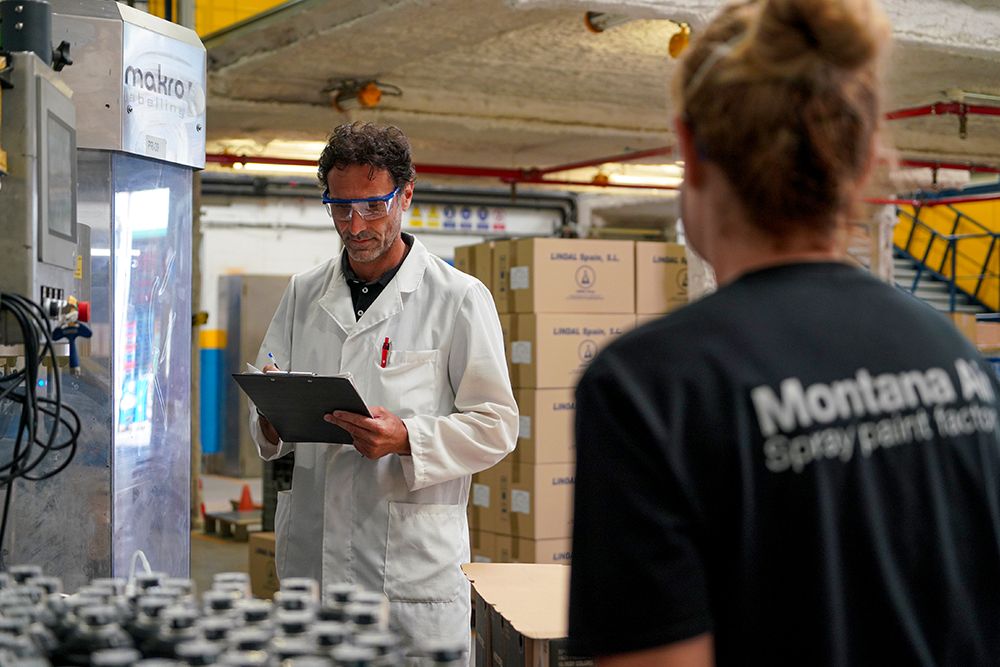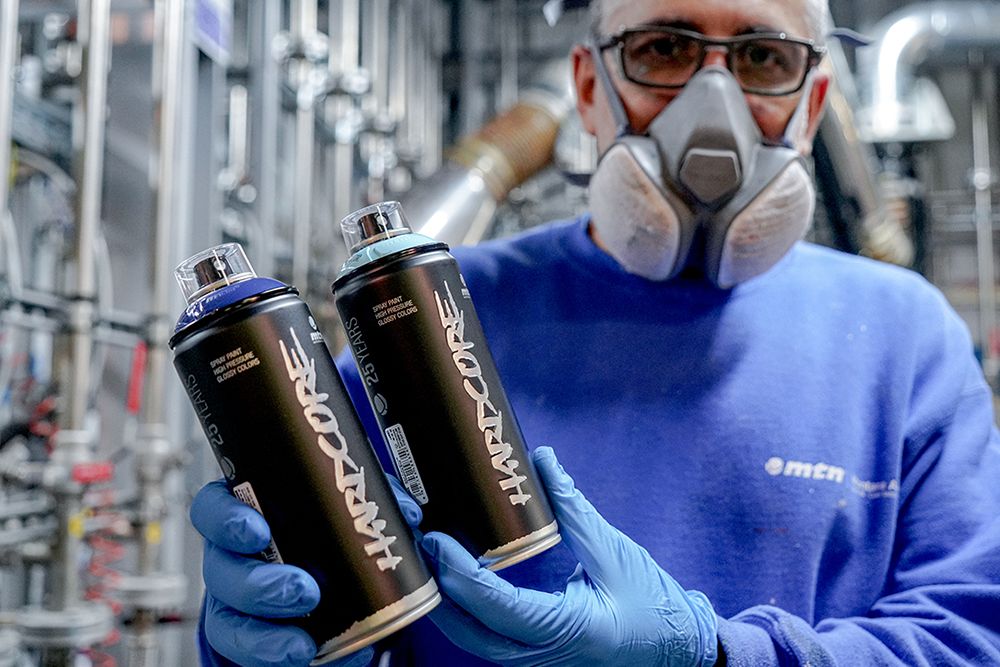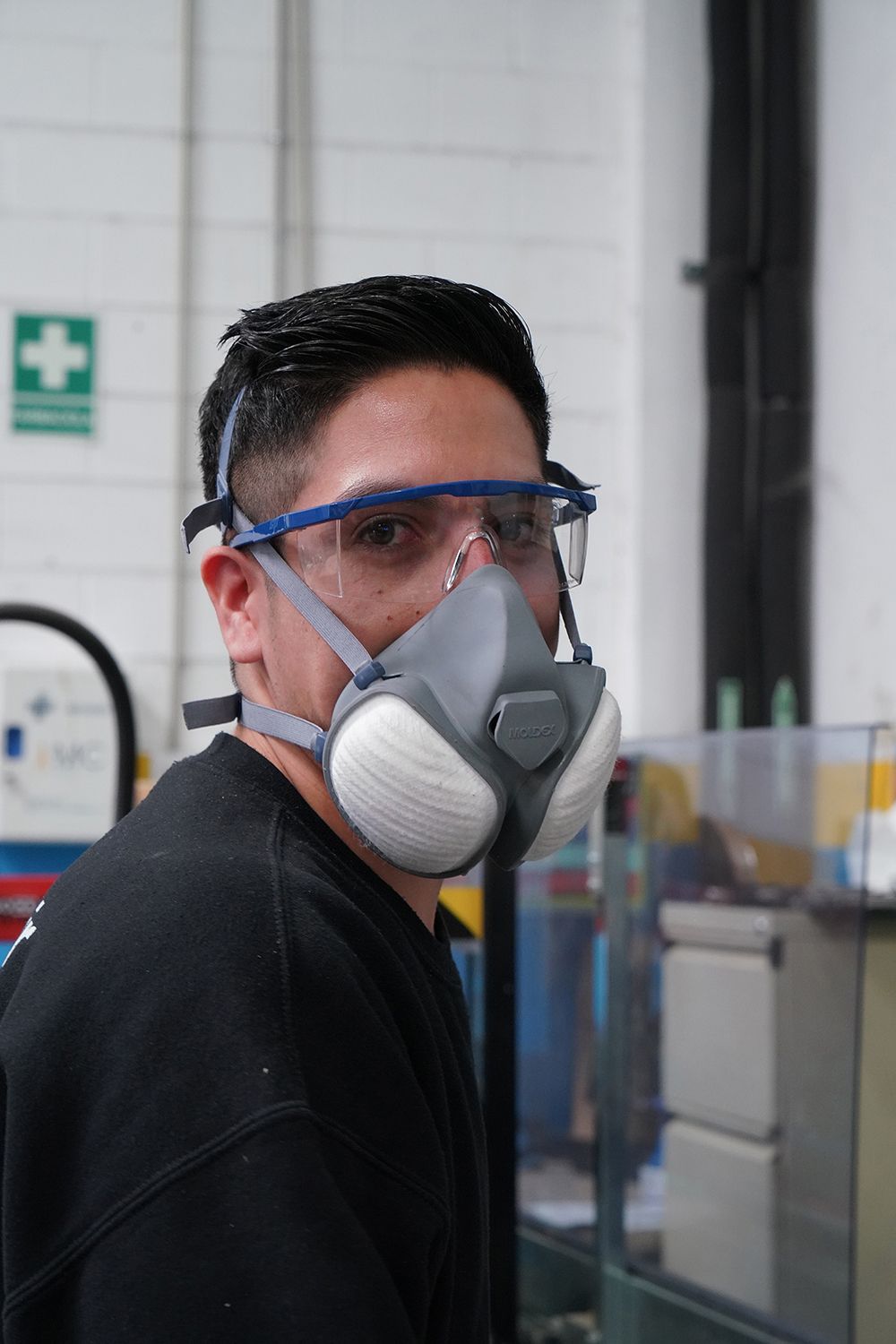- About MTN
Would you like to stay up to date on the latest MTN world news? Products, graffiti, murals, festivals, art and much more.
Return Interview with Miquel Molina, As head of ORP at Montana Colors
As head of ORP at MTN, which objectives do you prioritize for development on a day-to-day basis?
The safety and well-being of the people that make up MTN is a my priority, as well as making our workplaces a more pleasant and comfortable environment. Achieving zero unsafe situations is the desired outcome.
In the current situation of the pandemic, and the continued increase in protection and control measures, how do you assess both the adopted protocols and the response of the MTN workers?
In terms of risk analysis, control, and management, for years now MTN has been getting used to being as prepared as possible for any foreseeable scenarios, but also having policies and strategies in place that allow us to respond to atypical and difficult to predict situations.
Undoubtedly, in the face of unknown and unpredictable situations — like those that the pandemic has brought upon us — is when organizations demonstrate their strength and character. This is why I must congratulate each and every one of the people who make up MTN: for the determination with which they have adapted to this new reality, as well as the effort made and the responsibility demonstrated in complying with the demanding standards and protocols implemented. Undoubtedly, the measures have been effective, since we’ve been able to avoid wide-spread contagion, and consequently have been able to continue working and serving our customers as quickly as possible, with the highest safety and health measures.
How have you personally experienced the increase in preventative measures resulting from COVID-19?
As Head of ORP, the last few months were almost exclusively dedicated to managing the protection and prevention of Coronavirus infections. MTN is a company whose facilities and personnel are mainly in Barcelona, but also in Madrid, Seville, Montpelier, Sydney, Los Angeles and Hannover, so there have been complicated and difficult situations, both on work and non-work levels. The extraordinary situation we have found ourselves in has required extraordinary measures, all of them to protect our employees, clients, and interest groups, with the greater purpose of safeguarding the public health system, in order to avoid further collapse.
Is the training of workers in Occupational Risk Prevention the key to reducing workplace accidents?
ORP training is one of the fundamental pillars, but not the only one. Historically, the framework in which this knowledge was transmitted was always a typical session with a speaker and a group of passive listeners, but nowadays it’s necessary to be more efficient and effective. It’s necessary to increasingly monitor if the objectives set are being met, how many people are being reached and if there have been any positive behavioral changes…. It’s evident that safety culture goes beyond ordinary training. What’s really important are the day-to-day actions and practices of all its members, which serve as a true reflection of the adaptation of safe and responsible behavior.
The reduction of accidents must be based on the legislative framework for the prevention of occupational risks, which reinforces the business need and duty to integrate prevention in the company, in all its activities and hierarchical levels, through implementation and application. of a Prevention Plan.

Today, more than ever, the role of a responsible expert with training in ORP is important. How is this reflected at MTN? What kind of innovative tools do you have at MTN to train your employees?
Among the key competencies that a health and safety professional must have, is the basic ability to know how to interpret the environment. The current COVID-19 pandemic has allowed us to reflect on how to act in environments known as VUCA (Volatility, Uncertainty, Complexity and Ambiguity)
In this current scenario, MTN has been forced to adapt to the continuous changes that have been an attack on our strategic programming and production routines.
It’s been necessary to interpret the situation correctly, and with sufficient capacity to understand the potential circumstances affecting the reality of the company. Based on this, we were able to create an exhaustive diagnosis of the possible consequences, both for people and the processes. In this context of uncertainty, decisions with the greatest possibility of success and positive impact were made.
Regarding training — in terms of prevention, we’re a consolidated company, where all our employees have the technical training necessary to carry out their functions. But in prevention, it’s not enough to just know the procedures and the protective equipment thoroughly, but also be rigorous in applying and internalizing them.
For this reason, we have some tools such as the OPS (Preventive Observations on Safety) program, for example. Through this program, everyone can be the lead for detecting and quickly correcting situations that can be improved upon. It’s innovative and very interactive, where people are educated within their own environment, where they can still do their jobs and also continuously improve upon them.
The sectors that MTN operates in are particularly delicate: on the one hand, the chemical industry, and on the other, the aerosol industry — both of which are subject to strict safety standards. Could you highlight some basic and fundamental measures that, beyond specific external influences such as meteorological events, are a constant in day-to-day production?
Serious industrial risks are usually related to the possibility of fire, explosion or dispersion of chemical substances and generally come from material escaping from a container or installation, followed, in the case of highly volatile substances, by their evaporation and dispersion.
At MTN, the main risk is the possible escape of highly volatile flammable material, that would then mix with the air, forming a flammable vapor cloud and if that the cloud is near an ignition source or accumulated static electricity discharge, this would cause a fire or explosion.
Operations in EXAT (Explosive Atmosphere) environments are a constant in the basic development of both paint manufacturing and aerosol packaging plants. Due to the complexity of these industrial activities, risk control must be based on well-structured and systematic methods, on technical foundations such as a correct equipment design according to the classification of the work areas, as well as the auxiliary services, proper preventative measures, corrective and predictive maintenance, and adequate operating regulations in the various production centers.

In a company like MTN, there are a huge variety of work situations, so the preventative measures must be equally diverse — in production positions, in the laboratory, in the offices, or for those who are teleworking. How do you approach the overview required to meet the different needs inherent to each job?
To tailor to the needs of a company like MTN, multidisciplinary training and detailed knowledge of the operations of the various departments and areas is necessary. Certain skills and attitudes are required, all of them integrated into the same conceptual framework, which is none other than that defined by the relationship between working for others and guaranteeing health and well-being in their development.
On the way to success, it’s essential to work on values such as effort and perseverance. Likewise, it’s essential to focus the strategy on knowledge. The approach has to come from the perspective of studying and analysing the processes and the physicochemical properties of the products involved.
There are reasons to be optimistic, seeing that according to various indicators, everything points in the direction that in recent times workplace accidents have decreased in all sectors: is this also your impression? Do you think that raising ORP awareness in companies is improving?
Although occupational accidents have decreased, the reality is that there are still excessive deaths or accidents with very serious consequences for the development of work, and this fact is unacceptable. In my opinion, for companies in search of excellence, the 0 accident paradigm is inadequate, the objective should be to achieve zero unsafe situations, whether structural or behavioral. It’s about giving the least opportunity for risks to materialize, which leads to a much more rigorous and analytical work dynamic, this is the path chosen by MTN.
What do workers value most when they participate in an Occupational Risk Prevention training program?
They value what we all value when faced with training sessions that are dynamic, useful, entertaining. Above all, feeling that they are participants and not passive subjects who are being flooded and overwhelmed with information.
In a past that is fortunately more and more distant, MTN suffered several fires of different calibers in its facilities: did these mark a before and after in the development of the company's security protocols?
These events undoubtedly represented a turning point in risk control and management at MTN. The fight against accidents that generate fires begins in the preventive phase, a design in accordance with high standards of safety at the source. This is decisive for opting for significant investments in the best fire detection and extinction systems, both in passive and active safety measures.
One of the great gambles has been the digital transformation that integrates and digitizes variables related to fires in industrial processes. This gives us knowledge, adaptability and efficiency, by being able to collect and analyze data that allows us to monitor the areas with the highest risk in real time. This provides us with multiple scenarios and calculations of the probability of a potential accident materializing, and helping us understand the levels of vulnerability of our plants.
In this regard, another one of the improvements derived from the new MTN safety paradigm is the control of thermohygrometric conditions, physical and environmental conditions of temperature, humidity and ventilation, where work is carried out in production plants. We are also able to monitor the concentration levels of flammable vapors.
Tell us the strangest, funniest and most surprising thing that you’ve experienced in your career as Head of ORP at Montana Colors.
Well, for a somewhat square person like myself, at some point I have had to deal with an indiscriminate industrialist, who after a little pedagogical pep talk, understood that his outfit and shoes were not very suitable for working in an industrial environment.
And honestly, I hope I have no more surprises of any kind, my work is based on control and standardization, but above all, surprises aren’t good for my health hahahaha.
We know that work, like life, isn’t only about the good things, and it’s important to analyze the negatives in order to learn, improve or appreciate the positives even more. Are there any particular instances in your work where you suffered?
Unfortunately, it isn’t necessary to stray too far from today, the scenario that COVID-19 has left us with is cruel — many people are suffering and it gives you an overwhelming feeling of impotence since you can do very little to mitigate it.
On the positive side, I most value the various social causes that Montana Colors has committed to throughout all these years, from providing free material for socially impactful graffiti to be created in unfavorable environments, to making PPE material available to the healthcare system.
Do you have any link to the brand or its products outside of work?
Well, unfortunately, my artistic ability is quite limited. I have no choice but to admire the most recognized works wherever I travel for pleasure.
In a more domestic sense, I always turn to MTN products — they always provide good results, despite my inexperience and lack of skill.
Regarding other work experiences that you’ve had in life...what do you think differentiates Montana Colors from other companies?
The great difference lies in the active, tangible and real commitment by the Ownership and Management of MTN, who are aware that occupational safety and health is a part of operational management, and that only in this way can we protect the most valuable capital that MTN has our people.
What is your professional motto?
Nothing is that important, nor that urgent, that it cannot be carried out with all the necessary security measures.
 ShareJuly 17, 2020
ShareJuly 17, 2020
